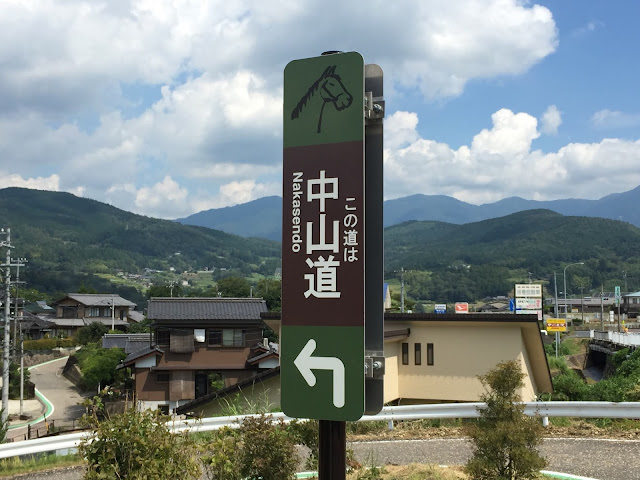In the early 17th century, the Tokugawa regime demanded that their courtiers travel between Edo and Kyoto on a regular basis, so many of them and their families traveled along the Nakasendo or yearly. The route was carefully planned, with villages established at convenient distances as "post towns" to provide lodging and food for official travelers. Some of these towns are well preserved, including two we visited, Magome and Tsumago.
We took a bullet train from Tokyo to Nagoya (wheeee!) and then a local train to Nakatsugawa, a town on the Nakasendo. Many travelers take a bus from Nakatsugawa to Magome, but we had decided to get an extra day of hiking in.
We left the station and walked up to the Nakasendo as it travels through Nakatsugawa. It wasn't super promising, to be honest. Though there were some nice older buildings.
We headed up the hill to the overpass, so well marked on the map.
There we saw our first "kosastuba", a replica notice board for travelers that was set up at either end of post towns on the Nakasendo.
Soon we reached the large red torii gate -- again marked on the map...
... and then we saw this on a signboard.
Would we be able to stay on the route through the town? Yep. #followtheyellowspeckledroad
Along the way we passed through countless shrines, beautifully maintained "rest stops" with spotlessly clean bathrooms, and plenty of signage to let us know we were on the right track.
We soon reached an old teahouse that was built to serve travelers. A few years ago the children of the last owners re-opened the teahouse, and served traditional food, including these "shiratama danga", sweet mochi dumplings with brown sugar.
The teahouse itself was lovely inside -- I can imagine in the cold winter to come this hearth would be very welcoming:
and lovely outside, too:
We continued along through rice fields ...
... and past small neighborhoods...
... until we arrived in the larger town of Ochiai. where we stopped in at a small grocery store to pick up picnic supplies -- some bread, some tofu, some drinks, some candy.
After making a a detour to visit a beautiful shrine with its multiple torii and kitsune statues:
we walked to a nearby bridge over a river and had some lunch.
The weather at this point was still really fine, but as we continued on into the forest we started to hear thunder. After climbing a steep hill, we arrived at the old stone pavement, a heavily restored section of paving that connects ancient fragments. This paving is called "ishidatami" -- literally "stone tatami". It's atmospheric and moody -- or maybe that's just a forest in a thunderstorm...
We stopped in a forest shelter as the first real wave of rain hit, but we were being eaten by mosquitos so decided to gore-tex up and move on. We soon arrived at another shelter, this one with a fancy bathroom. We stood there for a while watching the downpour ... at least until we noticed a nearby office for a mini golf course, with a large covered patio, lots of empty picnic tables, and vending machines.
When the rain passed, the heat returned, so we watched steam rise from the pavement as we walked through fields and the houses of a small village. We loved these ponds near most houses, and larger ones that served as fire control... and homes for fish.
The last stretch of the trail followed a narrow roadway that turns out to be the bus route. We didn't actually see any buses all day, but there aren't many in the afternoon .
The fields were vibrant and lush
Some had already been harvested:
Soon we arrived on the outskirts of Magome, right on schedule.
I admit it, we looked in the gift shops near the bus stop... but soon we headed up the old street.
The village is nearly all traditional buildings built after a devastating fire in 1895.
Many of them are shops, some are museums, and others are inns.
Our inn, Tajimaya, was the most beautiful of them all.
after a great night there, we would continue on to Nagiso via Tsumago and the Magome Pass.




































I am so enjoying these Sunny, even if I don't comment on every one! What an amazing group of experiences you had in Japan!
ReplyDeleteThanks Kathy! We so enjoyed our stay and it's fun for me to write them up and share the pictures.
Delete